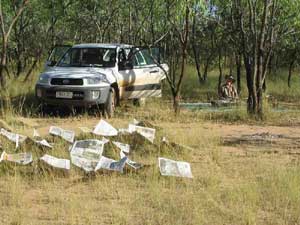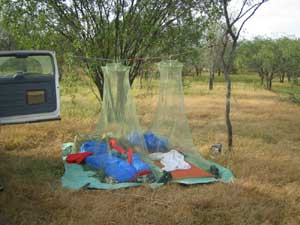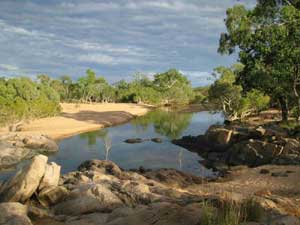 |
Centre for Australian National Biodiversity
Research
|
CPBR NEWS
Issue 60: April 2004
News from the Centre for Plant Biodiversity Research, Australian National Herbarium (CANB), for the information of CPBR and ANBG staff and volunteers.
CPBR News is produced monthly. If you wish to contribute, please email your suggestions to Val Oliver, the coordinator.
Val Oliver: ph (02) 6246 5533; fax (02) 6246 5249; email: Val.Oliver@csiro.au
********************
1. Staffing News
A warm welcome is extended to the following newly appointed staff members:
Ian Warren three year term with the Healthy Country Program.
Theresa Orchard three year term with the Healthy Country Program.
Luke Bulkeley three year term with the Healthy Country Program.
Walter Tate six month term replacing Bronwyn Matheson who is on secondment.
[Val Oliver]
********************
2. Australian National Herbarium
ERIN NVIS database reviewed
The National Vegetation Information System (NVIS) is a database managed by ERIN, part of the Department of the Environment and Heritage. NVIS is made up of vegetation community information collected by State/Federal herbaria and land management agencies to build vegetation maps for a variety of management purposes.
A small team at the CPBR has spent the last nine months reviewing the data quality of NVIS, providing recommendations on taxonomic and nomenclatural issues. Overall the data was of a high standard, though a number of issues were commented on; these included name duplication, name currency and infraspecific name problems. Jim Croft also provided recommendations on NVIS's potential role with regard to other national botanical databases such as APNI, WIN and SPRAT. A recommendations report was written for ERIN, this will be available shortly in the CPBR library.
Thanks go to Jim, Brendan, Laurie Adams and Jessie Szigethy-Gyula for their project input.
[Anthony Whalen]
********************
3. Research Groups
US visit
I recently conducted a privately-funded trip to the University of North Carolina at Wilmington during my annual leave. While in Wilmington, I delivered a seminar in the Department of Biology entitled "Pandemonium in Pussytoes: Reticulate and non-reticulate evolution in Antennaria (Asteraceae: Gnaphalieae)" at the invitation of Dr. Gregory Chandler. The talk went very well and stimulated a great deal of discussion at the end. During my visit substantial progress was made on completion of a NSF grant application to fund further research on genome evolution in Antennaria rosea, which Greg will submit to Washington this June.
Following my one week return to Australia, I traveled to Barcelona (Spain) at the invitation of the 2nd World Botanic Garden Congress. This trip was funded entirely by the Botanical Congress and private funds. On the weekend before the Congress, I attended a meeting of The International Compositae Alliance (TICA), where we planned our two symposia for the IBC next year in Vienna. Other attendees of this meeting were fellow synantherologists, Vicki Funk (Washington, D.C.), Alfonso Susanna (Barcelona), Christoph Oberprieler (Munich), Nuria Garcia-Jacas (Barcelona), and Marinda Koekemoer (Pretoria). We also discussed various other topics, such as continued development of the TICA website and planning for an International Compositae Conference for Barcelona in June 2006. On Sunday, Dr. Susanna took the group on a field trip to the mountains near Barcelona, where I collected two species of Phagnalon. These will be used in our Gnaphalieae phylogeny work. The 2nd Botanic Gardens Congress took place from the 19th to the 22nd of April at the Botanical Institute of Barcelona. About 460 representatives from botanic gardens in approximately 70 countries attended to meet, share opinions and experiences, and to discuss global conservation action. The Congress website can be found at:
http://www.bcn.es/medciencies/botanicgardens2004/en/ I delivered a talk entitled "Phylogenetic relationships of the Australasian citrus: the Citreae tribe in a world context", at which I had the audience eating out of my hand. The abstract for this talk may be found at: http://www.bcn.es/medciencies/botanicgardens2004/abstracts/pdf_abstracts/Bayer.pdf I have left a copy of the program in the tea room and have a CD with all congress abstracts for anyone that is interested in seeing them. The Congress itself was "interesting"; dealing primarily with policy issues that make administrators starry-eyed. However, there were also several very appealing sessions each day of hard-core botanical garden research presented. King's Park Botanic Garden botanists were prominent in this area presenting several interesting talks on conservation research from this WA garden. While in Catalonia, I also enjoyed several paellas and tours of the Sagrada Familia and the Salvadore Dali Museum.
[Randy Bayer]
********************
Chowilla Field Trip
One of the regions the Terrestrial Biological Water Benefits Healthy Country project is initially focussing on is the icon site, Chowilla, on the Murray River in South Australia. In early April, a team from the Herbarium (Judy West, Brendan Lepschi and Sophie Bickford), the Entomology collection (David Yeates and Tom Weir) and CSE vertebrate collection (Ian Mason) paid a flying visit to meet state agency stakeholders and to view the region.
We spent a day being shown around the Australian Landscape Trust’s owned and managed Calperum Station, visiting the river, anabranches, lakes, wetlands, floodplains and mallee regions of the property.
The following day was spent on the neighbouring Chowilla property, a once privately leased grazing property but recently added to the National Park system. Tony Herbert coordinator of land, water and salt management at Chowilla (SA Dept of Water, Land and Biodiversity Conservation) and Mike Harper, wetland manager (SA Dept of Environment & Heritage), guided us through Chowilla’s environments and management issues.
The trip was very successful. With the looming promise of environmental flow water to rejuvenate the highly stressed wetlands and floodplains of this region, managers require both baseline and ecological information on biodiversity of the area, to both guide e-flow delivery and monitor its effects.
The project, bringing together diversity analyses of the Murray-Darling Basin, Murray River corridor and species/taxon profiles or ecological attributes for a targeted range of plant, invertebrate and vertebrate groups were seen by the agencies to be highly complementary to already established research, and urgently required.
It was great combining the expertise from the three biological collections, we all learned much from each other in the field and generated many ideas on how to proceed. We returned excited by the prospect of carrying out a truly comprehensive diversity study, that combining the three collections allows.
[Sophie Bickford]
********************
Photographic/collecting trip, Qld Gulf country, 15 April–2 May.
Three weeks on the road, c. 4250 km covered in our trusty (hired) RAV, c. 200 species photographed & vouchers collected, and lots of fabulous camp sites under the stars now just memories. Our route was basically Cairns–Normanton/Karumba–Burketown–Mt Isa–Hughenden–Chillagoe–Cairns, with as many deviations as possible to avoid ‘main’ roads.
We had timed the trip to catch the flush of plants at the end of the wet season, but were about 3-4 weeks too late for that: despite what the weather maps seemed to be saying in the preceding months, they’d had a fairly dry wet. However, apart from the Mitchell Grass country between Cloncurry and Hughenden, we were stopping and backing up regularly to check out the flash of colour we’d glimpsed driving past. (We didn’t keep a tally of the number of km we drove in reverse – sometimes to the surprise of passing vehicles – but it was substantial!).
After picking up cardboards and jerry cans from Rebel Elick at Atherton, and copious quantities of newspaper (from a bottle shop) there, we escaped from the Tablelands as quickly as possible to get away from the rain, and basically enjoyed fine weather until we returned to the Great Dividing Range again a couple of weeks later. Despite advice from various tourist information centres to the contrary, all the Gulf roads we were interested in were open after the wet, even if some were pretty corrugated (ask Murray about the rattle in the RAV’s back door…).
Our route took us through a lot of different country – rainforest and semi-evergreen vine thickets; the grasslands (not a tree in sight) and grassy woodlands (mostly bloodwoods and ironbarks) of the plains; coastal mangroves; Melaleuca, Pandanus and river red gum ‘forests’ fringing the rivers; spinifex and low eucalypts in the rugged country north of Mt Isa. We got to actively avoid the grassy woodlands on the volcanic, basalt plains because their vegetation was so uniform (and boring!). The ‘plant count’ picked up each time we got into hilly country, and our rate of travel slowed accordingly.
Most interesting plant collected? – a low tree/tall shrub with metallic blue seeds. Most difficult plant to press? – a bloodwood with a ‘solid’ inflorescence c. 20 cm diameter. Most spectacular plant seen? – Grevillea decora shrubs covered in huge clusters of bright red flowers. Best swimming holes? – on the Lawn Hill River and Gregory River (water clear enough to see fish and turtles several metres deep). Best camp site? – Tate River (sandy pools, rapids, stately river red gums and Melaleucas, running water ... and plenty of rocks over which to drape (and weigh down) our wad of newspapers to dry them yet again for the presses). Worst camp? – south of Blackbraes National Park, with a howling gale all night, that also upended one of the camp chairs into the embers of the fire, where we discovered it gently smouldering the following morning.
[Rosemary Purdie]
*******************
4. General Centre Matters
Centre Program Meeting
The next meeting of the Centre/Program staff is scheduled for Wednesday 2 June 2004.
[Val Oliver]
********************
Executive Committee
The next meeting of the Executive Committee is scheduled for 9 June 2004.
[Val Oliver]



